Drout Advertising Research Project: Gender Stereotypes in Ads
VerifiedAdded on 2022/11/27
|10
|1742
|473
Report
AI Summary
This report presents an analysis of a research project investigating the relationship between advertisements and gender stereotypes. The study surveyed 105 respondents, collecting demographic, economic, and cultural data. The methodology employed frequency distributions, percentages, descriptive statistics, and a separate sample t-test to examine the impact of advertising on gender roles. The findings reveal that females constituted the majority of the respondents, with a significant portion holding bachelor's degrees. Income levels varied, with a substantial number earning in the lower income brackets. The analysis demonstrates that advertisements are perceived as influential in reinforcing gender stereotypes, with empowerment advertising showing potential in transforming cultural stereotypes. The study concludes that cultural gender stereotypes exist and advertisements play a role in either reinforcing or challenging these stereotypes. The report includes statistical tables and a discussion of the results, along with references to relevant literature.
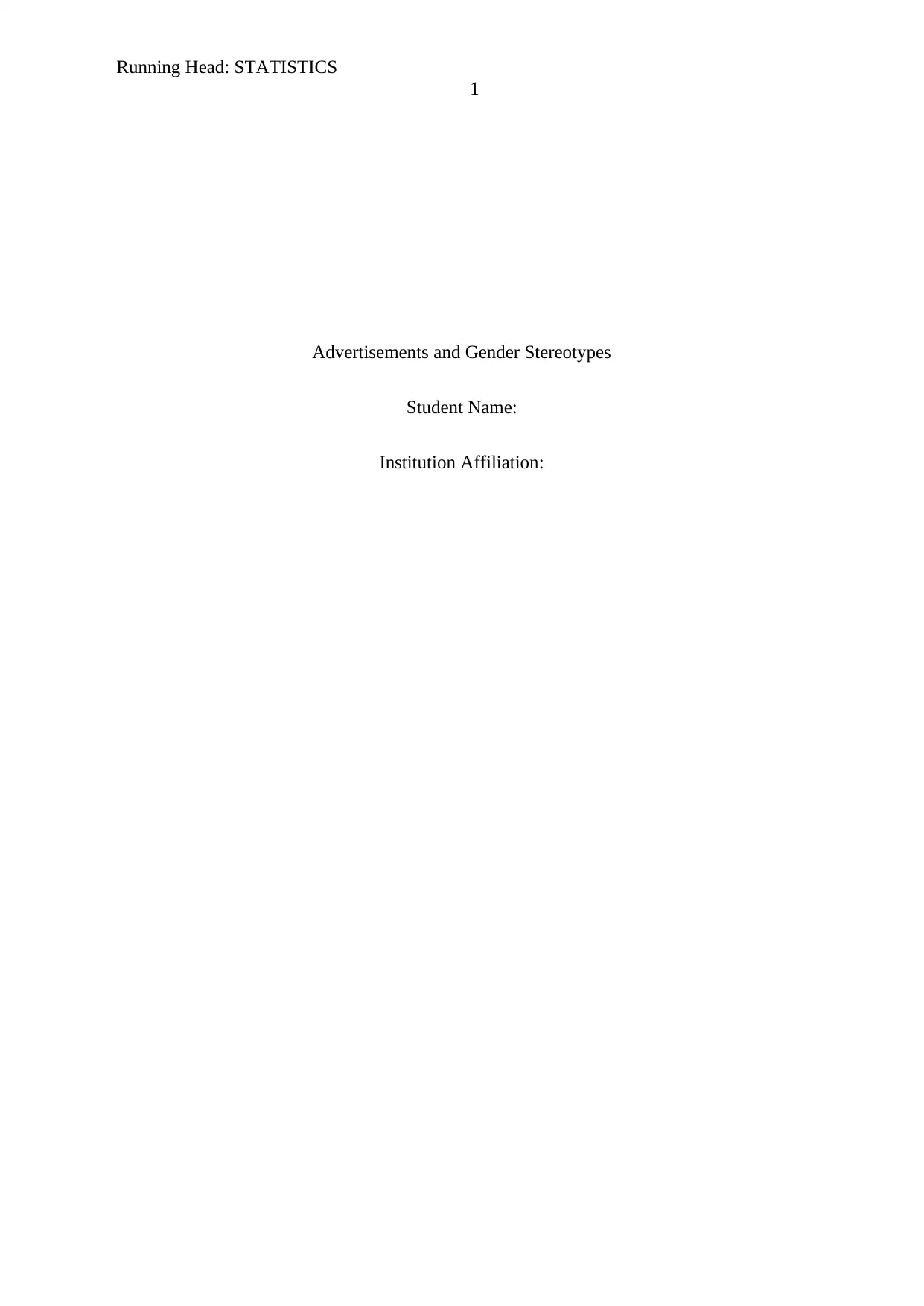
Running Head: STATISTICS
1
Advertisements and Gender Stereotypes
Student Name:
Institution Affiliation:
1
Advertisements and Gender Stereotypes
Student Name:
Institution Affiliation:
Paraphrase This Document
Need a fresh take? Get an instant paraphrase of this document with our AI Paraphraser
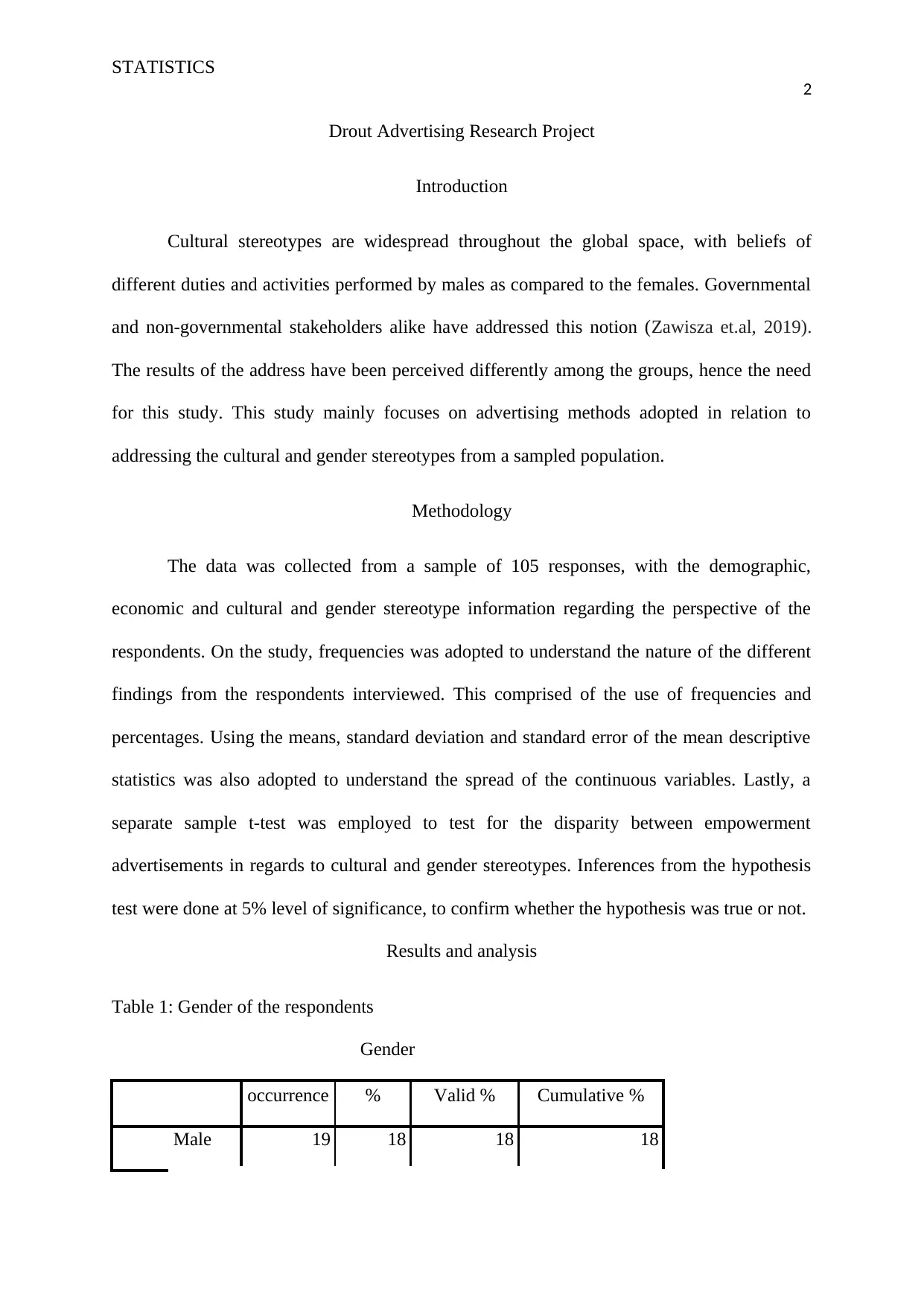
STATISTICS
2
Drout Advertising Research Project
Introduction
Cultural stereotypes are widespread throughout the global space, with beliefs of
different duties and activities performed by males as compared to the females. Governmental
and non-governmental stakeholders alike have addressed this notion (Zawisza et.al, 2019).
The results of the address have been perceived differently among the groups, hence the need
for this study. This study mainly focuses on advertising methods adopted in relation to
addressing the cultural and gender stereotypes from a sampled population.
Methodology
The data was collected from a sample of 105 responses, with the demographic,
economic and cultural and gender stereotype information regarding the perspective of the
respondents. On the study, frequencies was adopted to understand the nature of the different
findings from the respondents interviewed. This comprised of the use of frequencies and
percentages. Using the means, standard deviation and standard error of the mean descriptive
statistics was also adopted to understand the spread of the continuous variables. Lastly, a
separate sample t-test was employed to test for the disparity between empowerment
advertisements in regards to cultural and gender stereotypes. Inferences from the hypothesis
test were done at 5% level of significance, to confirm whether the hypothesis was true or not.
Results and analysis
Table 1: Gender of the respondents
Gender
occurrence % Valid % Cumulative %
Male 19 18 18 18
2
Drout Advertising Research Project
Introduction
Cultural stereotypes are widespread throughout the global space, with beliefs of
different duties and activities performed by males as compared to the females. Governmental
and non-governmental stakeholders alike have addressed this notion (Zawisza et.al, 2019).
The results of the address have been perceived differently among the groups, hence the need
for this study. This study mainly focuses on advertising methods adopted in relation to
addressing the cultural and gender stereotypes from a sampled population.
Methodology
The data was collected from a sample of 105 responses, with the demographic,
economic and cultural and gender stereotype information regarding the perspective of the
respondents. On the study, frequencies was adopted to understand the nature of the different
findings from the respondents interviewed. This comprised of the use of frequencies and
percentages. Using the means, standard deviation and standard error of the mean descriptive
statistics was also adopted to understand the spread of the continuous variables. Lastly, a
separate sample t-test was employed to test for the disparity between empowerment
advertisements in regards to cultural and gender stereotypes. Inferences from the hypothesis
test were done at 5% level of significance, to confirm whether the hypothesis was true or not.
Results and analysis
Table 1: Gender of the respondents
Gender
occurrence % Valid % Cumulative %
Male 19 18 18 18
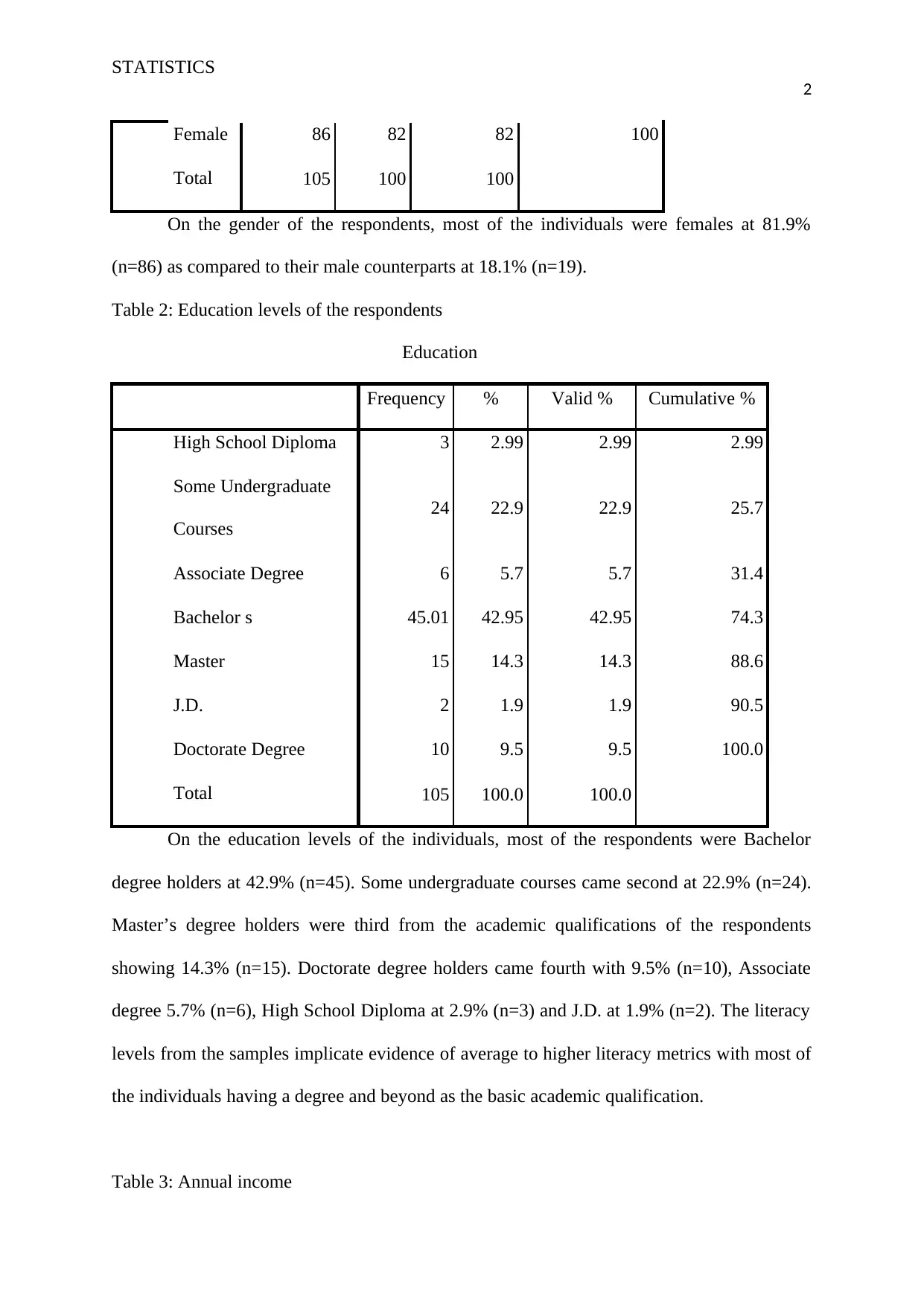
STATISTICS
2
Female 86 82 82 100
Total 105 100 100
On the gender of the respondents, most of the individuals were females at 81.9%
(n=86) as compared to their male counterparts at 18.1% (n=19).
Table 2: Education levels of the respondents
Education
Frequency % Valid % Cumulative %
High School Diploma 3 2.99 2.99 2.99
Some Undergraduate
Courses
24 22.9 22.9 25.7
Associate Degree 6 5.7 5.7 31.4
Bachelor s 45.01 42.95 42.95 74.3
Master 15 14.3 14.3 88.6
J.D. 2 1.9 1.9 90.5
Doctorate Degree 10 9.5 9.5 100.0
Total 105 100.0 100.0
On the education levels of the individuals, most of the respondents were Bachelor
degree holders at 42.9% (n=45). Some undergraduate courses came second at 22.9% (n=24).
Master’s degree holders were third from the academic qualifications of the respondents
showing 14.3% (n=15). Doctorate degree holders came fourth with 9.5% (n=10), Associate
degree 5.7% (n=6), High School Diploma at 2.9% (n=3) and J.D. at 1.9% (n=2). The literacy
levels from the samples implicate evidence of average to higher literacy metrics with most of
the individuals having a degree and beyond as the basic academic qualification.
Table 3: Annual income
2
Female 86 82 82 100
Total 105 100 100
On the gender of the respondents, most of the individuals were females at 81.9%
(n=86) as compared to their male counterparts at 18.1% (n=19).
Table 2: Education levels of the respondents
Education
Frequency % Valid % Cumulative %
High School Diploma 3 2.99 2.99 2.99
Some Undergraduate
Courses
24 22.9 22.9 25.7
Associate Degree 6 5.7 5.7 31.4
Bachelor s 45.01 42.95 42.95 74.3
Master 15 14.3 14.3 88.6
J.D. 2 1.9 1.9 90.5
Doctorate Degree 10 9.5 9.5 100.0
Total 105 100.0 100.0
On the education levels of the individuals, most of the respondents were Bachelor
degree holders at 42.9% (n=45). Some undergraduate courses came second at 22.9% (n=24).
Master’s degree holders were third from the academic qualifications of the respondents
showing 14.3% (n=15). Doctorate degree holders came fourth with 9.5% (n=10), Associate
degree 5.7% (n=6), High School Diploma at 2.9% (n=3) and J.D. at 1.9% (n=2). The literacy
levels from the samples implicate evidence of average to higher literacy metrics with most of
the individuals having a degree and beyond as the basic academic qualification.
Table 3: Annual income
⊘ This is a preview!⊘
Do you want full access?
Subscribe today to unlock all pages.

Trusted by 1+ million students worldwide
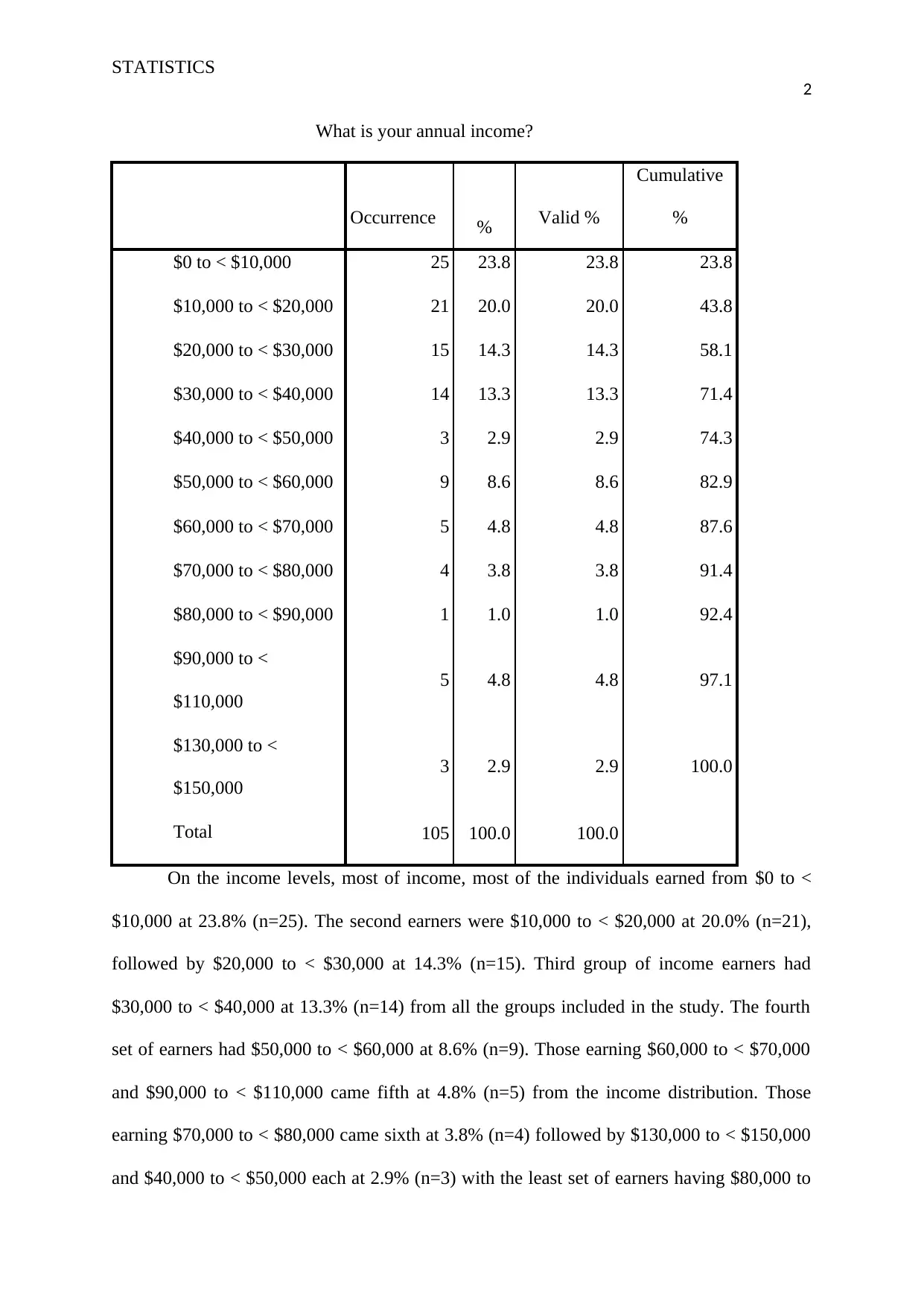
STATISTICS
2
What is your annual income?
Occurrence % Valid %
Cumulative
%
$0 to < $10,000 25 23.8 23.8 23.8
$10,000 to < $20,000 21 20.0 20.0 43.8
$20,000 to < $30,000 15 14.3 14.3 58.1
$30,000 to < $40,000 14 13.3 13.3 71.4
$40,000 to < $50,000 3 2.9 2.9 74.3
$50,000 to < $60,000 9 8.6 8.6 82.9
$60,000 to < $70,000 5 4.8 4.8 87.6
$70,000 to < $80,000 4 3.8 3.8 91.4
$80,000 to < $90,000 1 1.0 1.0 92.4
$90,000 to <
$110,000
5 4.8 4.8 97.1
$130,000 to <
$150,000
3 2.9 2.9 100.0
Total 105 100.0 100.0
On the income levels, most of income, most of the individuals earned from $0 to <
$10,000 at 23.8% (n=25). The second earners were $10,000 to < $20,000 at 20.0% (n=21),
followed by $20,000 to < $30,000 at 14.3% (n=15). Third group of income earners had
$30,000 to < $40,000 at 13.3% (n=14) from all the groups included in the study. The fourth
set of earners had $50,000 to < $60,000 at 8.6% (n=9). Those earning $60,000 to < $70,000
and $90,000 to < $110,000 came fifth at 4.8% (n=5) from the income distribution. Those
earning $70,000 to < $80,000 came sixth at 3.8% (n=4) followed by $130,000 to < $150,000
and $40,000 to < $50,000 each at 2.9% (n=3) with the least set of earners having $80,000 to
2
What is your annual income?
Occurrence % Valid %
Cumulative
%
$0 to < $10,000 25 23.8 23.8 23.8
$10,000 to < $20,000 21 20.0 20.0 43.8
$20,000 to < $30,000 15 14.3 14.3 58.1
$30,000 to < $40,000 14 13.3 13.3 71.4
$40,000 to < $50,000 3 2.9 2.9 74.3
$50,000 to < $60,000 9 8.6 8.6 82.9
$60,000 to < $70,000 5 4.8 4.8 87.6
$70,000 to < $80,000 4 3.8 3.8 91.4
$80,000 to < $90,000 1 1.0 1.0 92.4
$90,000 to <
$110,000
5 4.8 4.8 97.1
$130,000 to <
$150,000
3 2.9 2.9 100.0
Total 105 100.0 100.0
On the income levels, most of income, most of the individuals earned from $0 to <
$10,000 at 23.8% (n=25). The second earners were $10,000 to < $20,000 at 20.0% (n=21),
followed by $20,000 to < $30,000 at 14.3% (n=15). Third group of income earners had
$30,000 to < $40,000 at 13.3% (n=14) from all the groups included in the study. The fourth
set of earners had $50,000 to < $60,000 at 8.6% (n=9). Those earning $60,000 to < $70,000
and $90,000 to < $110,000 came fifth at 4.8% (n=5) from the income distribution. Those
earning $70,000 to < $80,000 came sixth at 3.8% (n=4) followed by $130,000 to < $150,000
and $40,000 to < $50,000 each at 2.9% (n=3) with the least set of earners having $80,000 to
Paraphrase This Document
Need a fresh take? Get an instant paraphrase of this document with our AI Paraphraser

STATISTICS
2
< $90,000 at 1.0% (n=1). The distribution shows that most of the respondents earning range
from $0 to < $10,000, $10,000 to < $20,000 and $20,000 to < $30,000.
Table 4: Roles, if any, of advertisements have in reinforcing specific gender stereotypes
Reinforcing
Occurence % Valid % Cumulative %
Drastic 35 33.33 33.33 33.33
Influentia
l
62 59.0 59.0 92.4
Limited 5 4.8 4.8 97.1
Trivial 3 2.9 2.9 100.0
Total 105 100.0 100.0
On the roles, if any, the impact of commercials adverts in reinforcement of specific
forms of gender stereotypes, most of them were quite influential at 59.0% (n=62) followed by
drastic roles at 33.3% (n=35). Influential 4.8% (n=5) and Trivial 2.9% (n=3) were the least
based on the roles of advertisements in relation to the reinforcement of gender stereotypes.
Table 5: The scope on empowerment advertising communicates the distinct differences in
each personality and would be helpful in transforming gender and cultural stereotypes.
Transform
Occurrence % Valid %
Cumulative
%
Strongly Agree 32 31 31 31
Agree 30 28.6 28.6 59.0
Somewhat Agree 35 33.3 33.3 92.4
Neutral 6 5.7 5.7 98.1
2
< $90,000 at 1.0% (n=1). The distribution shows that most of the respondents earning range
from $0 to < $10,000, $10,000 to < $20,000 and $20,000 to < $30,000.
Table 4: Roles, if any, of advertisements have in reinforcing specific gender stereotypes
Reinforcing
Occurence % Valid % Cumulative %
Drastic 35 33.33 33.33 33.33
Influentia
l
62 59.0 59.0 92.4
Limited 5 4.8 4.8 97.1
Trivial 3 2.9 2.9 100.0
Total 105 100.0 100.0
On the roles, if any, the impact of commercials adverts in reinforcement of specific
forms of gender stereotypes, most of them were quite influential at 59.0% (n=62) followed by
drastic roles at 33.3% (n=35). Influential 4.8% (n=5) and Trivial 2.9% (n=3) were the least
based on the roles of advertisements in relation to the reinforcement of gender stereotypes.
Table 5: The scope on empowerment advertising communicates the distinct differences in
each personality and would be helpful in transforming gender and cultural stereotypes.
Transform
Occurrence % Valid %
Cumulative
%
Strongly Agree 32 31 31 31
Agree 30 28.6 28.6 59.0
Somewhat Agree 35 33.3 33.3 92.4
Neutral 6 5.7 5.7 98.1
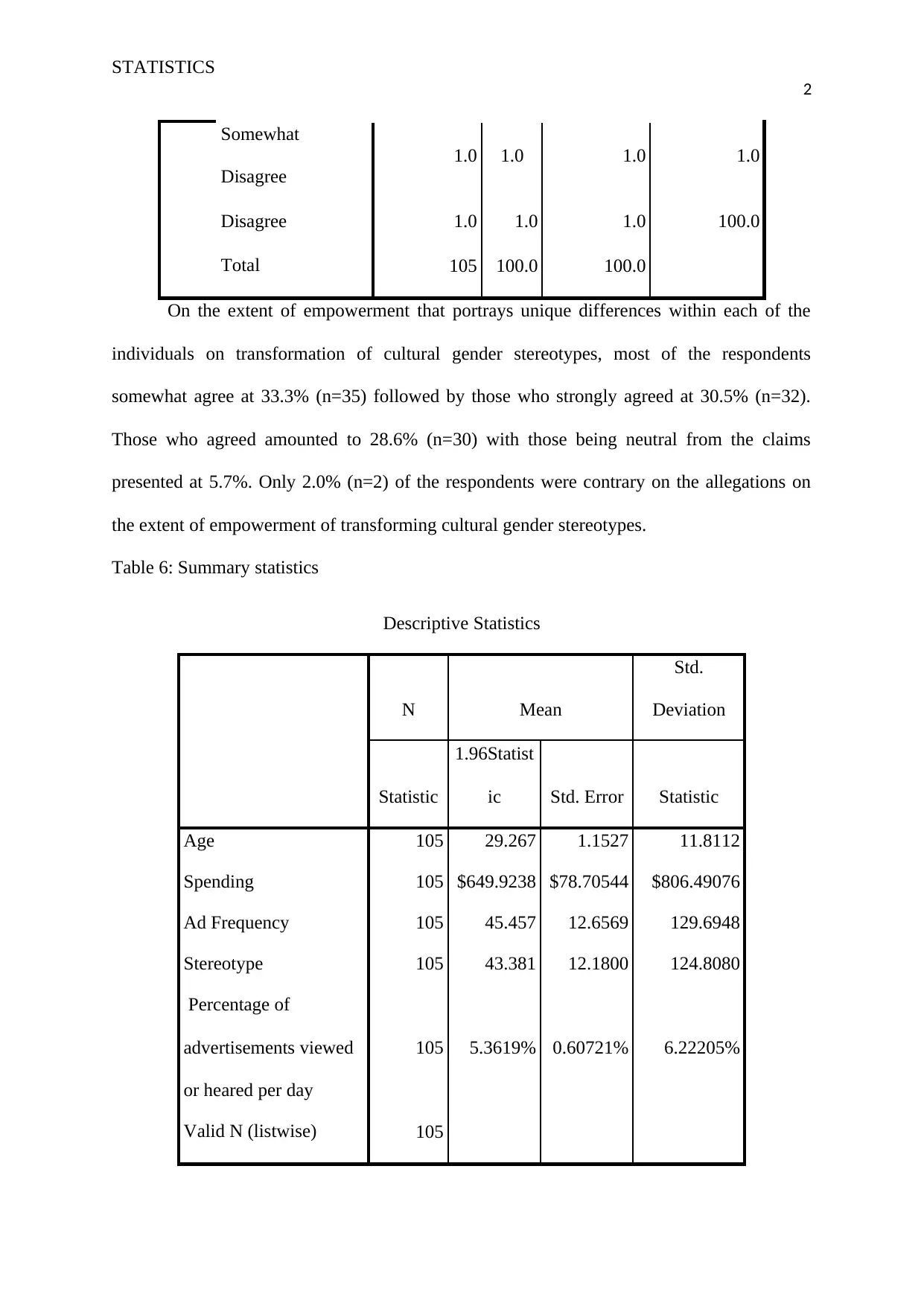
STATISTICS
2
Somewhat
Disagree
1.0 1.0 1.0 1.0
Disagree 1.0 1.0 1.0 100.0
Total 105 100.0 100.0
On the extent of empowerment that portrays unique differences within each of the
individuals on transformation of cultural gender stereotypes, most of the respondents
somewhat agree at 33.3% (n=35) followed by those who strongly agreed at 30.5% (n=32).
Those who agreed amounted to 28.6% (n=30) with those being neutral from the claims
presented at 5.7%. Only 2.0% (n=2) of the respondents were contrary on the allegations on
the extent of empowerment of transforming cultural gender stereotypes.
Table 6: Summary statistics
Descriptive Statistics
N Mean
Std.
Deviation
Statistic
1.96Statist
ic Std. Error Statistic
Age 105 29.267 1.1527 11.8112
Spending 105 $649.9238 $78.70544 $806.49076
Ad Frequency 105 45.457 12.6569 129.6948
Stereotype 105 43.381 12.1800 124.8080
Percentage of
advertisements viewed
or heared per day
105 5.3619% 0.60721% 6.22205%
Valid N (listwise) 105
2
Somewhat
Disagree
1.0 1.0 1.0 1.0
Disagree 1.0 1.0 1.0 100.0
Total 105 100.0 100.0
On the extent of empowerment that portrays unique differences within each of the
individuals on transformation of cultural gender stereotypes, most of the respondents
somewhat agree at 33.3% (n=35) followed by those who strongly agreed at 30.5% (n=32).
Those who agreed amounted to 28.6% (n=30) with those being neutral from the claims
presented at 5.7%. Only 2.0% (n=2) of the respondents were contrary on the allegations on
the extent of empowerment of transforming cultural gender stereotypes.
Table 6: Summary statistics
Descriptive Statistics
N Mean
Std.
Deviation
Statistic
1.96Statist
ic Std. Error Statistic
Age 105 29.267 1.1527 11.8112
Spending 105 $649.9238 $78.70544 $806.49076
Ad Frequency 105 45.457 12.6569 129.6948
Stereotype 105 43.381 12.1800 124.8080
Percentage of
advertisements viewed
or heared per day
105 5.3619% 0.60721% 6.22205%
Valid N (listwise) 105
⊘ This is a preview!⊘
Do you want full access?
Subscribe today to unlock all pages.

Trusted by 1+ million students worldwide
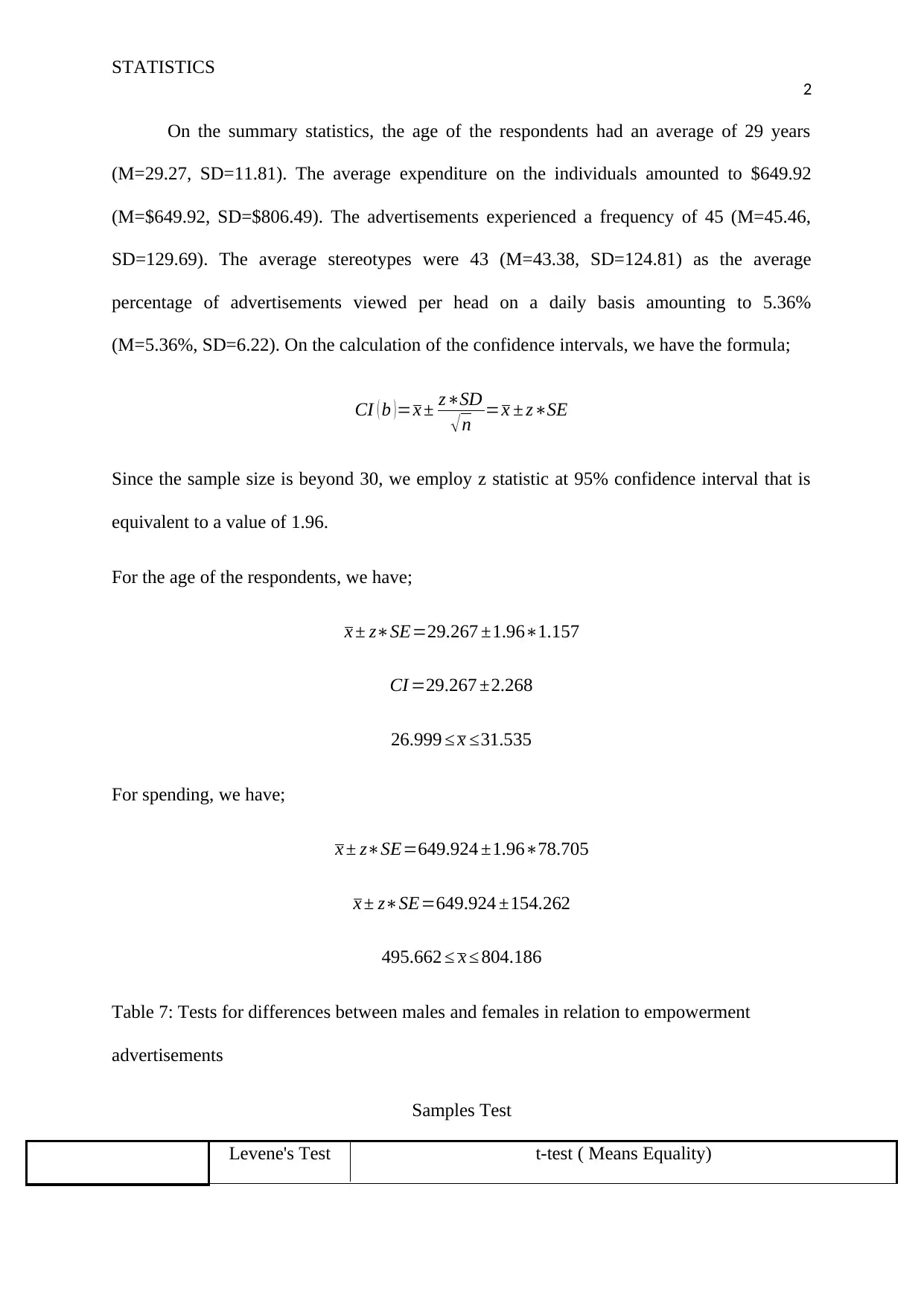
STATISTICS
2
On the summary statistics, the age of the respondents had an average of 29 years
(M=29.27, SD=11.81). The average expenditure on the individuals amounted to $649.92
(M=$649.92, SD=$806.49). The advertisements experienced a frequency of 45 (M=45.46,
SD=129.69). The average stereotypes were 43 (M=43.38, SD=124.81) as the average
percentage of advertisements viewed per head on a daily basis amounting to 5.36%
(M=5.36%, SD=6.22). On the calculation of the confidence intervals, we have the formula;
CI ( b )=x ± z∗SD
√n =x ± z∗SE
Since the sample size is beyond 30, we employ z statistic at 95% confidence interval that is
equivalent to a value of 1.96.
For the age of the respondents, we have;
x ± z∗SE=29.267 ±1.96∗1.157
CI =29.267 ±2.268
26.999 ≤ x ≤31.535
For spending, we have;
x ± z∗SE=649.924 ±1.96∗78.705
x ± z∗SE=649.924 ±154.262
495.662 ≤ x ≤ 804.186
Table 7: Tests for differences between males and females in relation to empowerment
advertisements
Samples Test
Levene's Test t-test ( Means Equality)
2
On the summary statistics, the age of the respondents had an average of 29 years
(M=29.27, SD=11.81). The average expenditure on the individuals amounted to $649.92
(M=$649.92, SD=$806.49). The advertisements experienced a frequency of 45 (M=45.46,
SD=129.69). The average stereotypes were 43 (M=43.38, SD=124.81) as the average
percentage of advertisements viewed per head on a daily basis amounting to 5.36%
(M=5.36%, SD=6.22). On the calculation of the confidence intervals, we have the formula;
CI ( b )=x ± z∗SD
√n =x ± z∗SE
Since the sample size is beyond 30, we employ z statistic at 95% confidence interval that is
equivalent to a value of 1.96.
For the age of the respondents, we have;
x ± z∗SE=29.267 ±1.96∗1.157
CI =29.267 ±2.268
26.999 ≤ x ≤31.535
For spending, we have;
x ± z∗SE=649.924 ±1.96∗78.705
x ± z∗SE=649.924 ±154.262
495.662 ≤ x ≤ 804.186
Table 7: Tests for differences between males and females in relation to empowerment
advertisements
Samples Test
Levene's Test t-test ( Means Equality)
Paraphrase This Document
Need a fresh take? Get an instant paraphrase of this document with our AI Paraphraser
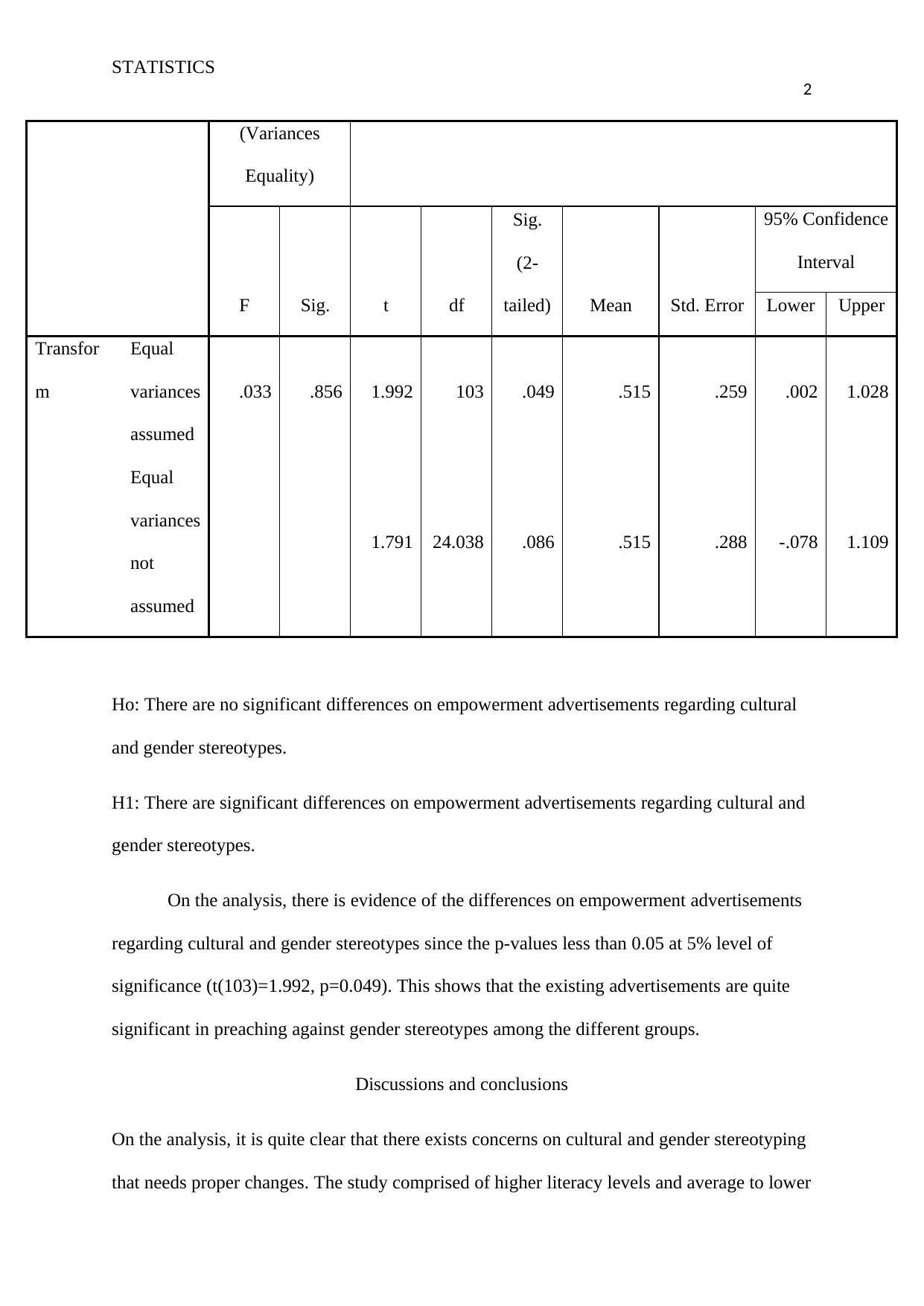
STATISTICS
2
(Variances
Equality)
F Sig. t df
Sig.
(2-
tailed) Mean Std. Error
95% Confidence
Interval
Lower Upper
Transfor
m
Equal
variances
assumed
.033 .856 1.992 103 .049 .515 .259 .002 1.028
Equal
variances
not
assumed
1.791 24.038 .086 .515 .288 -.078 1.109
Ho: There are no significant differences on empowerment advertisements regarding cultural
and gender stereotypes.
H1: There are significant differences on empowerment advertisements regarding cultural and
gender stereotypes.
On the analysis, there is evidence of the differences on empowerment advertisements
regarding cultural and gender stereotypes since the p-values less than 0.05 at 5% level of
significance (t(103)=1.992, p=0.049). This shows that the existing advertisements are quite
significant in preaching against gender stereotypes among the different groups.
Discussions and conclusions
On the analysis, it is quite clear that there exists concerns on cultural and gender stereotyping
that needs proper changes. The study comprised of higher literacy levels and average to lower
2
(Variances
Equality)
F Sig. t df
Sig.
(2-
tailed) Mean Std. Error
95% Confidence
Interval
Lower Upper
Transfor
m
Equal
variances
assumed
.033 .856 1.992 103 .049 .515 .259 .002 1.028
Equal
variances
not
assumed
1.791 24.038 .086 .515 .288 -.078 1.109
Ho: There are no significant differences on empowerment advertisements regarding cultural
and gender stereotypes.
H1: There are significant differences on empowerment advertisements regarding cultural and
gender stereotypes.
On the analysis, there is evidence of the differences on empowerment advertisements
regarding cultural and gender stereotypes since the p-values less than 0.05 at 5% level of
significance (t(103)=1.992, p=0.049). This shows that the existing advertisements are quite
significant in preaching against gender stereotypes among the different groups.
Discussions and conclusions
On the analysis, it is quite clear that there exists concerns on cultural and gender stereotyping
that needs proper changes. The study comprised of higher literacy levels and average to lower
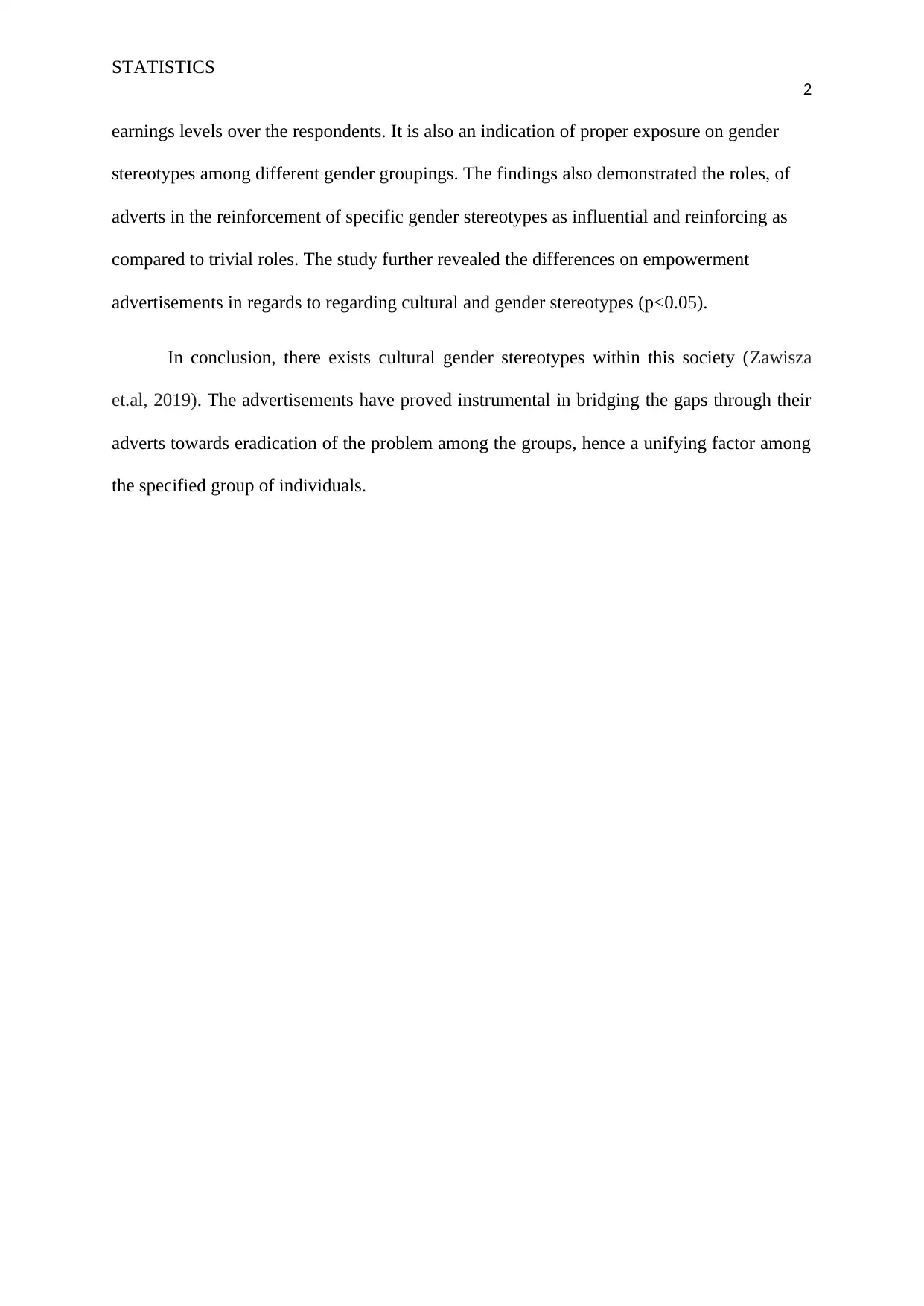
STATISTICS
2
earnings levels over the respondents. It is also an indication of proper exposure on gender
stereotypes among different gender groupings. The findings also demonstrated the roles, of
adverts in the reinforcement of specific gender stereotypes as influential and reinforcing as
compared to trivial roles. The study further revealed the differences on empowerment
advertisements in regards to regarding cultural and gender stereotypes (p<0.05).
In conclusion, there exists cultural gender stereotypes within this society (Zawisza
et.al, 2019). The advertisements have proved instrumental in bridging the gaps through their
adverts towards eradication of the problem among the groups, hence a unifying factor among
the specified group of individuals.
2
earnings levels over the respondents. It is also an indication of proper exposure on gender
stereotypes among different gender groupings. The findings also demonstrated the roles, of
adverts in the reinforcement of specific gender stereotypes as influential and reinforcing as
compared to trivial roles. The study further revealed the differences on empowerment
advertisements in regards to regarding cultural and gender stereotypes (p<0.05).
In conclusion, there exists cultural gender stereotypes within this society (Zawisza
et.al, 2019). The advertisements have proved instrumental in bridging the gaps through their
adverts towards eradication of the problem among the groups, hence a unifying factor among
the specified group of individuals.
⊘ This is a preview!⊘
Do you want full access?
Subscribe today to unlock all pages.

Trusted by 1+ million students worldwide
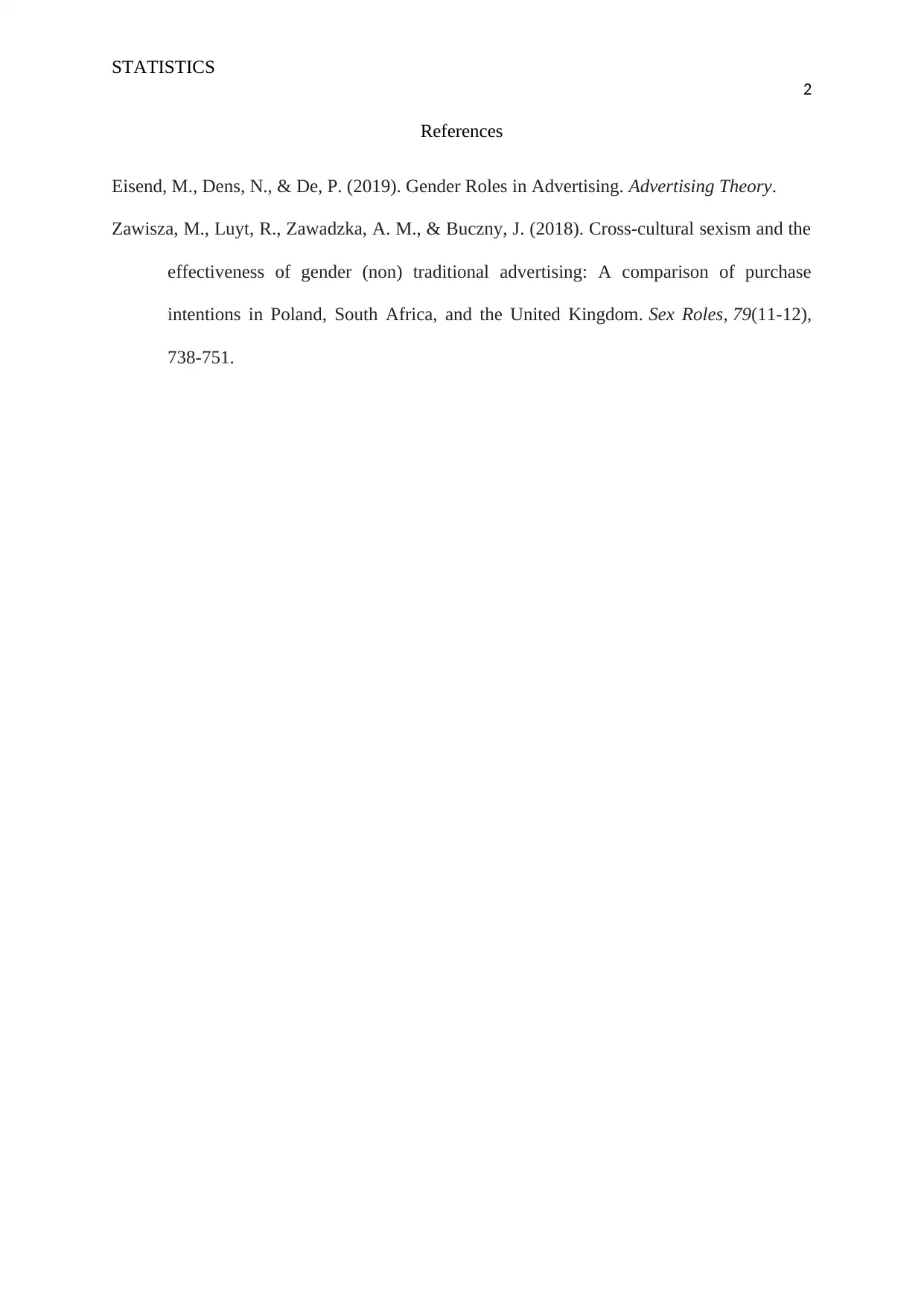
STATISTICS
2
References
Eisend, M., Dens, N., & De, P. (2019). Gender Roles in Advertising. Advertising Theory.
Zawisza, M., Luyt, R., Zawadzka, A. M., & Buczny, J. (2018). Cross-cultural sexism and the
effectiveness of gender (non) traditional advertising: A comparison of purchase
intentions in Poland, South Africa, and the United Kingdom. Sex Roles, 79(11-12),
738-751.
2
References
Eisend, M., Dens, N., & De, P. (2019). Gender Roles in Advertising. Advertising Theory.
Zawisza, M., Luyt, R., Zawadzka, A. M., & Buczny, J. (2018). Cross-cultural sexism and the
effectiveness of gender (non) traditional advertising: A comparison of purchase
intentions in Poland, South Africa, and the United Kingdom. Sex Roles, 79(11-12),
738-751.
1 out of 10
Your All-in-One AI-Powered Toolkit for Academic Success.
+13062052269
info@desklib.com
Available 24*7 on WhatsApp / Email
![[object Object]](/_next/static/media/star-bottom.7253800d.svg)
Unlock your academic potential
Copyright © 2020–2025 A2Z Services. All Rights Reserved. Developed and managed by ZUCOL.